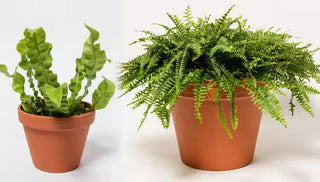Lush, feathery, ferns are one of the oldest groups of plants on Earth and have been adorning our planet for millions of years. Belonging to the Pteridophyta division, these non-flowering plants reproduce via spores and are known for their distinctive, divided leaves known as fronds. With over 10,000 known species, ferns are an incredibly diverse assemblage with huge variations in color, form, and size.
Tucked under the dappled shade of a tree, they are a gorgeous groundcover. But as a houseplant? While nearly maintenance-free outside, ferns can be a bit diva-like indoors. But don't get discouraged! Once you dial in the correct humidity and light, ferns are fantastic houseplants that give your home a forested vibe. Learn how to care for these leafy beauties.
Types of Ferns
For beginners, resilient types like the Boston fern or the Kangaroo fern are great choices. These varieties are less sensitive to humidity, and adapt well to indoor conditions. Here are excellent ferns for indoor growing:
| Common Name | Botanical Name | Description |
|---|---|---|
| Boston fern | Nephrolepis exaltata | Hardy and easy to care for, with dense, pinnate fronds |
| Bird's Nest fern | Asplenium nidus | Shiny, slightly crinkled leaves |
| Blue-star fern | Phlebodium aureum | Tidy blue-green leaves grow upward |
| Button fern | Pellaea rotundifolia | Round, tiny leaflets sport a waxy, water-retaining coating |
| Kangaroo Paw fern | Microsorum diversifolium | Glossy, large, dark green fronds |
| Maidenhair fern | Adiantum tenerum | Delicate, wiry stems with dainty leaflets |
| Squirrel's Foot fern | Davallia trichomanoides | Fuzzy rhizomes and ruffled, trailing fronds |
| Staghorn fern | Platycerium bifurcatum | Leathery fronds grow in overlapping layers |
Best Growing Conditions for Ferns
Light
Ferns generally prefer dappled, indirect light. Too much direct sunlight can scorch their leaves, while too little can stunt their growth. A north-facing window or a spot that receives filtered light is ideal.
Soil
Ferns thrive in moist, but not waterlogged, conditions — a well-draining potting mix rich in organic matter is essential. Look for mixes containing peat moss or perlite, which help retain moisture and allow air to reach the roots.
Humidity
Almost all types of ferns require consistent humidity. Mist your fern regularly (and more frequently in the dry winter months), position them in a humid bathroom, or consider setting them in a room with a humidifier.
How To Care For Ferns
Watering
Watering is crucial and varies depending on the humidity and temperature. Ferns prefer consistently moist soil. Check the top inch of soil, and if it feels dry, it’s time to water.
Fertilizing
While not particularly heavy feeders, ferns do benefit from a regular dose of weak fertilizer. Opt for a half-strength solution to avoid over-fertilizing, which can harm the fern. During the growing season (spring and summer), a balanced, water-soluble fertilizer can be used monthly.
Pruning
Pruning isn't usually necessary, but you can trim away any brown or dead fronds to encourage healthy growth and improve appearance.
Repotting Ferns
Ferns should be repotted every couple of years or when they outgrow their current pot. Use a slightly larger pot and fresh potting mix to give them room to grow.
Propagating Ferns
Ferns can be propagated by dividing the plant during repotting. Gently separate the roots and plant each section in its own pot.
Common Problems with Ferns
Pests and Diseases
Watch out for pests like aphids, mealybugs, and spider mites. Diseases like root rot can occur if the soil is too waterlogged. Ensure good air circulation and avoid overwatering.
Toxicity
Most ferns are non-toxic, making them safe for homes with pets. However, some varieties like the Asparagus fern (Asparagus densiflorus; and not actually a true fern) can be toxic to pets.
Fern FAQs
Q: How can I increase humidity for my indoor ferns?
A: Ferns love heaps of humidity. You can increase humidity by misting the leaves, placing a water tray near the plant, or using a humidifier. Try keeping your fern in a steamy bathroom.
Q: Why are the fronds of my fern turning yellow?
A: Yellow fronds could be a sign of overwatering, underwatering, or lack of nutrients. Check the soil moisture and ensure you’re following a balanced watering and fertilizing schedule.
Q: Can ferns survive outdoors in winter?
A: This depends on the fern type and of course, your grow zone! Japanese painted ferns (hardy in zones 4-8), Autumn fern (zones 4-9), Ostrich ferns (zones 3-7), and Christmas ferns (zones 3-8) can all be grown outside as perennials. Tuck them in a protected part of the garden in moist soil and part-shade.
Tropical ferns (i.e. Australian Tree ferns, kangaroo ferns, rabbit’s foot ferns) are not cold-tolerant and need to be grown indoors as houseplants.
Despite their slighty fussy reputation, ferns remain popular, beloved houseplants. Have patience, and don’t be afraid to experiment with watering, soil, and placement within your home until you find a combination of conditions that works for your fern!




